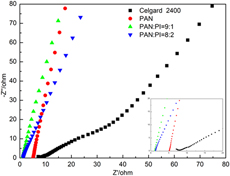Crossref Citations
This article has been cited by the following publications. This list is generated based on data provided by
Crossref.
Mohanta, Jagdeep
Kwon, O Hyeon
Choi, Jong Hyeok
Yun, Yeo-Myeong
Kim, Jae-Kwang
and
Jeong, Sang Mun
2019.
Preparation of Highly Porous PAN-LATP Membranes as Separators for Lithium Ion Batteries.
Nanomaterials,
Vol. 9,
Issue. 11,
p.
1581.
Singh, Rupali
Janakiraman, S.
Khalifa, Mohammed
Anandhan, S.
Ghosh, Sudipto
Venimadhav, A.
and
Biswas, K.
2020.
A high thermally stable polyacrylonitrile (PAN)-based gel polymer electrolyte for rechargeable Mg-ion battery.
Journal of Materials Science: Materials in Electronics,
Vol. 31,
Issue. 24,
p.
22912.
Li, Manni
Zhang, Zhoujie
Yin, Yuting
Guo, Weichang
Bai, Yuge
Zhang, Fan
Zhao, Bin
Shen, Fei
and
Han, Xiaogang
2020.
Novel Polyimide Separator Prepared with Two Porogens for Safe Lithium-Ion Batteries.
ACS Applied Materials & Interfaces,
Vol. 12,
Issue. 3,
p.
3610.
Liu, Hao
Gough, Christopher R.
Deng, Qianqian
Gu, Zhenggui
Wang, Fang
and
Hu, Xiao
2020.
Recent Advances in Electrospun Sustainable Composites for Biomedical, Environmental, Energy, and Packaging Applications.
International Journal of Molecular Sciences,
Vol. 21,
Issue. 11,
p.
4019.
Zhong, Nainbing
Xin, Xin
Liu, Huimin
Yu, Xiaoyi
Chang, Haixing
Tang, Bing
Zhong, Dengjie
Zhao, Mingfu
Zhang, Hongmin
and
Zhao, Jie
2020.
Plastic optical fiber sensor for temperature-independent high-sensitivity detection of humidity.
Applied Optics,
Vol. 59,
Issue. 19,
p.
5708.
Xia, Yang
Li, Yao
Xiao, Zhen
Zhou, Xiaozhen
Wang, Guoguang
Zhang, Jun
Gan, Yongping
Huang, Hui
Liang, Chu
and
Zhang, Wenkui
2020.
β-Cyclodextrin-modified porous ceramic membrane with enhanced ionic conductivity and thermal stability for lithium-ion batteries.
Ionics,
Vol. 26,
Issue. 1,
p.
173.
Lin, Wen
Jiao, Jiajia
Li, Hao
Li, Danpeng
Zhu, Taiyang
Song, Jiangping
Zhao, Shenqiu
Guo, Weibin
and
Tang, Haolin
2020.
Organic‐Inorganic Composite Porous Membrane for Stable and High‐Performance Lithium‐Ion Battery.
ChemistrySelect,
Vol. 5,
Issue. 4,
p.
1308.
Martins, P.M.
Nunes-Pereira, J.
Lanceros-Méndez, S.
and
Costa, C.M.
2020.
Synthetic Polymeric Membranes for Advanced Water Treatment, Gas Separation, and Energy Sustainability.
p.
383.
DeMeuse, Mark T.
2021.
Polymer-Based Separators for Lithium-Ion Batteries.
p.
93.
Palanisamy, Manikandan
Lin, Keng-Wei
Lo, Chieh-Tsung
and
Pol, Vilas G.
2022.
In Situ Thermal Safety Aspect of the Electrospun Polyimide-Al2O3 Separator Reveals Less Exothermic Heat Energies Than Polypropylene at the Thermal Runaway Event of Lithium-Ion Batteries.
ACS Applied Materials & Interfaces,
Vol. 14,
Issue. 24,
p.
28310.
Zhang, Siyuan
Wang, Xiang
Liang, Jianyu
Gu, Jianbo
Feng, Xiangyang
and
Xu, Chengze
2022.
Preparation of High Performance Lithium‐Ion Battery Separators by Double‐Needle Electrospinning.
ChemistrySelect,
Vol. 7,
Issue. 44,
Hu, Huakun
Xue, Wendong
Jiang, Peng
Li, Yong
and
Foot, Peter
2022.
Polyimide-Based Materials for Lithium-Ion Battery Separator Applications: A Bibliometric Study.
International Journal of Polymer Science,
Vol. 2022,
Issue. ,
p.
1.
Chen, Weiping
Wang, Xiang
Liang, Jianyu
Chen, Yao
Ma, Wei
and
Zhang, Siyuan
2022.
A High Performance Polyacrylonitrile Composite Separator with Cellulose Acetate and Nano-Hydroxyapatite for Lithium-Ion Batteries.
Membranes,
Vol. 12,
Issue. 2,
p.
124.
Gozali Balkanloo, Peyman
Poursattar Marjani, Ahmad
Zanbili, Fatemeh
and
Mahmoudian, Mehdi
2022.
Clay mineral/polymer composite: characteristics, synthesis, and application in Li-ion batteries: A review.
Applied Clay Science,
Vol. 228,
Issue. ,
p.
106632.
Cao, Dongqing
Deng, Jianhui
Jiang, Liqin
Li, Xinxi
and
Zhang, Guoqing
2022.
Designing polyimide/polyacrylonitrile/polyimide sandwich composite separator for rechargeable lithium-ion batteries.
Journal of Energy Storage,
Vol. 55,
Issue. ,
p.
105496.
Luo, Wei
Mei, Shun-qi
Liu, Teng
Yang, Li-ye
and
Fan, Ling-ling
2022.
Preparation and tensile conductivity of carbon nanotube/polyurethane nanofiber conductive films based on the centrifugal spinning method.
Nanotechnology,
Vol. 33,
Issue. 13,
p.
135708.
Rafikov, Adham
Mirzayev, Nodir
and
Alimkhanova, Sevara
2022.
Multilayer nonwoven lining materials made of wool and cotton for clothing and footwear.
Journal of Industrial Textiles,
Vol. 51,
Issue. 4_suppl,
p.
6173S.
Mei, Shunqi
Liu, Teng
Chen, Long
and
Wang, Yifan
2023.
Preparation and Performance of a PU/PAN Lithium-Ion Battery Separator Based on a Centrifugal Spinning Method.
Applied Sciences,
Vol. 13,
Issue. 11,
p.
6682.
Song, Changyong
Gao, Chao
Peng, Qinggang
Gibril, Magdi E.
Wang, Xiaohui
Wang, Shoujuan
and
Kong, Fangong
2023.
A novel high-performance electrospun of polyimide/lignin nanofibers with unique electrochemical properties and its application as lithium-ion batteries separators.
International Journal of Biological Macromolecules,
Vol. 246,
Issue. ,
p.
125668.
Kumar, Niranjan
Sahu, Dinesh K.
and
Mahipal, Y. K.
2023.
Effect of TiO2 on ion transport properties and dielectric relaxation of sodium ion-conducting novel PEO/PAN-blended solid polymer electrolyte.
Journal of Materials Research,
Vol. 38,
Issue. 9,
p.
2506.





